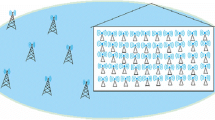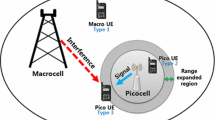Abstract
IMT-Advanced mobile communication systems make it possible for any devices to access high-speed networks anytime and anywhere. To meet the needs of IMT-Advanced systems, cellular systems must solve the problem of intercell interference caused by frequency reuse. Intercell interference problems become severe when orthogonal frequency division multiplexing (OFDM) transmission, which is a key technology for 4G communication systems, is used in a cellular system. In this paper, a zone-based intercell interference coordination (ICIC) scheme with high flexibility and low cost is proposed, and its performance is evaluated through multicell system-level simulations carried out according to the simplified 3GPP (3rd Generation Partnership Project) Long Term Evolution (LTE) system parameters. In the proposed algorithm, each cell is divided into several regions based on threshold values. Each region reuses frequencies in different ways, and the regions have different maximum transmit (TX) powers according to the interference environment. Even though the proposed scheme can be implemented with low complexity by using only the existing user equipment (UE) measurement, simulation results have confirmed that it provides significant improvements in geometry distribution.
Similar content being viewed by others
References
3GPP. (2006). Requirement for evolved UTRA (E-UTRA) and evolved UTRAN (E-UTRAN), TR 25.913.
CEWiT. (2008). IMT advanced technical requirements—an India perspective, 3GPP REV-080050, Shenzhen, China, April 7–8.
3GPP. (2008). Requirement for further advancements for E-UTRA (LTE-Advanced), TR 36.913.
Ericsson. (2005). Inter-cell interference handling for E-UTRA, 3GPP R1-050764, London, UK, Aug. 29–Sep. 2.
RITT. (2005). Inter-cell interference mitigation based on IDMA, 3GPP R1-050608, Sophia Antipolis, France, June 20–21.
Qualcomm. (2005). Description and simulation of interference management technique for OFDMA based E-UTRA downlink evaluation, 3GPP R1-050896, London, United Kingdom, Aug. 29–Sep. 2.
Qualcomm. (2005). Further description of dynamic FFR for OFDM based E-UTRA downlink, 3GPP R1-051123, San Diego, USA, Oct. 10–14.
Alcatel. (2005). Interference coordination in new OFDM DL air interface, 3GPP R1-050407, Athens, Greece, May 9–13.
Alcatel. (2005). Multi-cell simulation results for interference coordination in new OFDM DL, 3GPP R1-050694, London, United Kingdom, Aug. 29–Sep. 2.
Alcatel. (2005). Interference coordination for evolved UTRA uplink access, 3GPP R1-050695, London, United Kingdom, Aug. 29–Sep. 2.
ETRI. (2005). Inter-cell interference management in practical environments, 3GPP R1-050808, London, UK, Aug. 29–Sep. 2.
ETRI. (2005). Resource allocation for interference mitigation with symbol repetition in E-UTRA downlink, 3GPP R1-051085, San Diego, USA, Oct. 10–14.
Kwon J., Lee H., Ahn J. (2008) Perofrmance of unified inter-cell interference avoidance and cancellation in OFDM mobile cellular systems. The Journal of Korea Informtion and Communications Society 33(4): 371–376
Huawei. (2005). Soft frequency reuse scheme for UTRAN LTE, 3GPP R1-050507, Athens, Greece, May 9–13.
Huawei. (2005). Further analysis of soft frequency reuse Scheme, 3GPP R1-050841, London, United Kingdom, Aug. 29–Sep. 2.
Ericsson & NTT DoCoMo. (2006). Downlink and uplink inter-cell interference co-ordination/avoidance impact on the specifications, 3GPP R1-060586, Denver, USA, Feb. 13–17.
Siemens. (2005). Interference mitigation—considerations and results on frequency reuse, 3GPP R1-050738, London, United Kingdom, Aug. 29–Sep. 2.
Siemens. (2006). Interference mitigation by partial frequency Reuse, 3GPP R1-060670, Denver, USA, Feb. 13–17.
LGE. (2005). Interference mitigation in evolved UTRA/UTRAN, 3GPP R1-050833, London, United Kingdom, Aug. 29–Sep. 2.
Nokia. (2005). UL interference control considerations, 3GPP R1-050813, London, United Kingdom, Aug. 29–Sep. 2.
LGE. (2005). Standard aspects of interference coordination for E-UTRA, 3GPP R1-051051, San Diego, USA, Oct. 10–14.
NEC. (2008). NECs view on requirements of LTE advanced, REV-080021, 3GPP RAN IMT Advanced Workshop, Shenzhen, China, April 7–8.
Alcatel-Lucent. (2008). Requirements and concepts for LTE advanced, REV-080044, 3GPP RAN IMT advanced workshop, Shenzhen, China, April 7–8.
Motorola. (2008). LTE advanced technical proposals, REV-080011, 3GPP RAN IMT advanced workshop, Shenzhen, China, April 7–8.
Ericsson. (2008). LTE-Advanced, technology components, REV-080030, 3GPP RAN IMT advanced workshop, Shenzhen, China, April 7–8.
Alcatel-Lucent. (2008). LTE-advanced candidate technologies, REV-080048, 3GPP RAN IMT advanced workshop, Shenzhen, China, April 7–8.
3GPP TSG RAN. (2010). Evolved universal terrestrial radio access (E-UTRA); physical channels and modulation, TS 36.211 (Release9), March 2010.
Ericsson. (2008). Additional RSRP reporting trigger for ICIC, 3GPP R1-081536, Shenzhen, China, March 31–April 4.
3GPP TSG RAN. (2010). Evolved universal terrestrial radio access (E-UTRA); physical layer procedures, TS 36.213 (Release9), Sep. 2010.
3GPP TSG RAN. (2006). Physical layer aspects for evolved Universal terrestrial radio access (UTRA), 3GPP TR 25.814.
Author information
Authors and Affiliations
Corresponding author
Additional information
“This work was supported by the 2011 research fund of Myongji University in Korea”. “This research was supported by the MKE (The Ministry of Knowledge Economy), Korea, under the ITRC (Information Technology Research Center) support program supervised by the NIPA (National IT Industry Promotion Agency) (NIPA-2010-C1090-1011-0008). This study was financially supported by Special Research Program of Chonnam National University, 2009. This work was supported by the National Research Foundation of Korea Grant funded by the Korean Government (NRF-2010-013-D00046)”.
Rights and permissions
About this article
Cite this article
You, C., Yoon, G., Seo, C. et al. Intercell Interference Coordination Using Threshold-Based Region Decisions. Wireless Pers Commun 59, 789–806 (2011). https://doi.org/10.1007/s11277-011-0265-z
Published:
Issue Date:
DOI: https://doi.org/10.1007/s11277-011-0265-z




